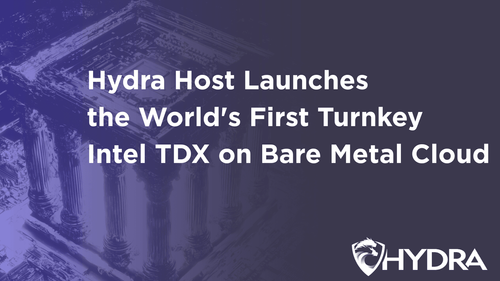Beyond the Cloud: Get Ahead on Sky Computing
In software, everyone wants to be in on the Next Big Thing™. Of course, identifying that Thing can be tricky. Today, Hydra is doing that work for you. In this primer we’ll cover:
- What is Sky Computing, and why it’s quickly emerging as the Next Big Thing
- Sky Computing use cases, and how it compliments other trends such as AI/ML
- How it works, the different implementation approaches, and their trade-offs
- How industry adoption is likely to play out
- The early companies and projects, like Hydra Host, poised to be early major players
Whether you’re a software developer, platform/DevOps engineer, or a business owner, if you rely on the cloud and want to keep a competitive edge, being early to the Sky Computing discussion is a must.
The goal of this article is to provide a high-level primer on this subject and its ongoing emergence, with actionable starting points on how to get in on the ground floor to the benefit of your career, business, and customers.
What even is this Thing
“Sky Computing” registers under 1,000 monthly searches on Google, so what is it, and why are we certain it’s not just a Thing, but poised to be a Big Thing?
The term was cemented relatively recently in a paper titled “The Sky Above the Clouds: A Berkley View on the Future of Cloud Computing” by Ion Stoica and company, and is meant to evoke a radical extension and enhancement of today’s cloud computing landscape.
As the name suggests, the central idea of Sky Computing is users should be able to leverage all different clouds and other resource providers, whether major hyperscalers, independent datacenters, or edge compute, as easily as they’re able to leverage a single cloud provider. Rather than being reliant on any single cloud, the entire skyscape of computing should be at all of our fingertips.
It’s worth noting that there are competing terms being used to describe the same ideas, including “Supercloud” and even “Metacloud”. None have a clear edge yet, but Sky Computing has the benefit of being a completely novel term without any of the potential baggage of previous associations. The “Sky Above The Clouds” paper also does the best job of comprehensively describing the technology and challenges so far.
The Problem
Cloud was a pivotal step forward for the software industry. The cloud allowed a natural division between two compute spaces - the building and maintaining of applications and the operating hardware required to host them. However, the cloud as it works today also has significant down-sides.
Today, all the major clouds have one anti-feature in common: cloud vendor lock in. Once you’ve built your entire infrastructure to a particular provider, shifting to another one entirely is typically a complicated and expensive undertaking.
As a result, what we have today are different isolated “clouds”, or walled gardens with little agility and optionality for businesses. On the macro scale, this reduces competition and increases pricing. On the micro scale, this means the norm is to be forced to entirely rely on a single hosting operator for business operations, continuity, and their ongoing fair pricing and policies.
Multi-Cloud is a Cry for Help
Businesses already intuitively understand the criticality of the issues associated with being stuck with a single provider and are working to imperfectly address them.
The factors pushing these enterprises towards leveraging new providers stretch from cost optimization, to available geographic locations, and to the need for diversification in the event of a provider outage. However, in Hydra’s experience of offering multi-cloud advisory and consultation services, most businesses are multi-cloud in the sense that they leverage other providers to deploy new services, rather than making legacy services cloud agnostic and multi-cloud capable. This is because migrating legacy infrastructure built to a specific cloud remains so difficult.
Managing disparate resources across providers creates its own problems however, due to the burden of orchestrating and maintaining multiple different cloud infrastructure stacks and accounts which sport their own distinct tool chains and interfaces.
There’s a better way, and that’s exactly what Sky Computing aims to achieve.
The Next Big Thing
Imagine a single dashboard that allows you to click and choose which provider you deploy your resources to, filterable by variables such as prices, locations, latency estimates, historical uptime, performance, compliance standards, and legal jurisdictions. You can deploy any of your services and applications independently to whichever provider is a superior fit for the needs of that particular component, while also redeploying them as often as there is new favorable options to take advantage of.
Substituting this dashboard with an API or Terraform provider enables the same capabilities programatically, allowing you to build pipelines which can deploy and redeploy services to different providers automatically depending on stated preferences.
One obvious use case for these capabilities is the ability to shop around for the best deal on compute intensive operations, such as model training for machine learning. Whenever you’re ready to begin a new job training a model from a large data set, you can do an active search of the least expensive (or most performant) hardware available on the market to leverage.
Another use case is the ability to compare and choose between all resources available that meet required jurisdictional or compliance guidelines, such as GDPR, HIPAA, or ISO. Yet another can be optimizing for uptime, by spreading clusters of the same critical service across multiple different providers as an active risk management strategy.
How It Works
The key component required for unlocking this experience and the subsequent use cases is described by the Sky Above the Clouds authors as a “intercloud brokerage”, or what Hydra Host originally conceived as an “arbitrage layer.” These brokers serve as a middleware layer and API gateway for each cloud provider, providing a unified and standardized interface for leveraging all of their resources. They do the work of integrating and maintaining the interfaces of the various cloud providers, so you can focus on your application level services.
Several projects are already pursuing differing visions of this broker-like model today, Hydra Host included. Differing approaches exist with different sets of tradeoffs. The largest distinction to be made in categorizing them so far is what we call either the maximalist approach or the minimalist approach (what the Sky Above the Clouds refers to as a “shim layer”).
Maximalist vs Minimalist
The goal of the maximalist cloud broker approach is to piece together and standardize the interfaces for the various product catalogues of the major cloud service providers. This can include high level services such as EKS, RDS, data analytics tools, and more.
The advantage here is the significant demand and use cases for combining the best services from all providers, say RDS from AWS and data analytic tools from GCP, as they are widely used. Given the sheer number of services that cloud providers now provide, and the inherent complexity of higher-level services, there is a disadvantage. Building and maintaining an ever-growing list of products across clouds becomes tricky to scale and maintain even for a company dedicated to the function.
On the other hand, the goal of the minimalist approach is to conversely bridge only the lowest levels of cloud and hosting resources together, such as compute, storage, and networking. Once bridged, a protocol like standard is provided on top so higher-level services can be rebuilt on to a common interface. This interface is natively cloud agnostic, meaning applications built on top of it are able to run uniformly in all hosting environments without changes.
The advantage to the minimalist approach is that integrations with different providers are far simpler to build and maintain than the maximalist approach. There are fewer moving targets and less complexity. Like any good protocol, this approach makes the “broker” strategy much simpler to understand and lightweight to run. Additionally, it is easier to quickly integrate hosting providers. This expands possibilities far beyond the major cloud providers, including the large landscape of independent data centers and rapidly growing number of edge compute locations. Furthermore, this approach forces providers to compete on the commodity level that is the hardware, increasing competition where it can have the biggest daily impact: your wallet.
The downside of the minimalist approach is development complexity. Development shifts from integration work to redeveloping the infrastructure stack, meaning that the platform won’t be ideal right away for every application if they are heavily reliant on higher level cloud services like EKS. This will be overcome through time as the infrastructure stack matures and offers effective analogues to common high level cloud services.
Adoption Roadmap
So, what will the rollout of Sky Computing look like? Right now, adoption is nascent, which provides more upside for the innovators and early adopters. Ultimately, the adoption path will be influenced by one major factor: friction. While cloud brokers make it easy to deploy applications to multiple clouds by offering a unified interface, migrating off cloud interfaces to sky brokers takes the same type of work that makes cloud migration a pain to begin with.
This means that similar to current multi-cloud trends, most early adoption of the intercloud broker model will come from new services and applications. Emerging startups and SMBs are uniquely positioned to leverage this technology, as they are relatively unencumbered by sprawling legacy applications.
However, another group that that is well positioned to be early adopters includes large enterprises who are already facing the need to undergo infrastructure migrations. Perhaps this is due to recent M&A or simply an effort to dramatically cut costs. For comparable effort, these enterprises can migrate to a Sky Computing model to solve their dilemma and never have to worry about extensive hosting migration pains ever again.
Getting Involved
It’s not often that you’re able to get in on the ground floor of a powerful new paradigm, but here we are. There are multiple “broker” providers to explore which we’ve outlined here (non-exhaustively, we’re sure), and given the early stages all are easy to reach out to. We, of course, encourage you to read the original "The Sky Above the Clouds" paper, and other links in this article.
Here at Hydra Host we’re working on launching a State of the Sky newsletter you can subscribe to if interested, as well as a community chat which we’ll keep subscribers alerted to. Sky Computing is poised to effectively address rampant pain points in today’s cloud computing landscape and change the entire cost benefit equation distributed computing. Together, we can build a community of early practitioners that can accelerate this change and provide outsized benefits for early adopters.
Inter-Cloud Brokers:
- Hydra Host: We’ve been researching and experimenting with various approaches to the “arbitrage/broker” function since April 2021, settling on a Minimalist strategy. We’re working with early adopters to onboard them on to our fully managed platform, with plans to open source our software in the second half of 2023. 2023 roadmap goes beyond public clouds, and integrating independent bare metal value providers. Make sure to contact us for a demo or if interested in our future newsletter, and keep an eye on our blog!
- Controlplane: Founded in 2019, it allows user to mix and match cloud services from the big 3 (AWS, GCP, Azure) in the vein of our described “Maximalist” Sky strategy.
- Upbound: Founded in 2017, Unbound is building a universal cloud platform powered by their crossplane framework, which can be self hosted to help manage a variety of service providers.
- Anyscale: Founded in 2019, Anyscale is a platform to run “Ray” based AI/ML workloads on top of any cloud. From the outside they seem to employ a more minimalist strategy to ensure workloads are inherently more portable, and is focused entirely on the hosted Ray use case, for now.
We’ll be expanding this list on an ongoing basis as we see more players in the inter-cloud broker space continue to appear. If we missed anyone, let us know!



